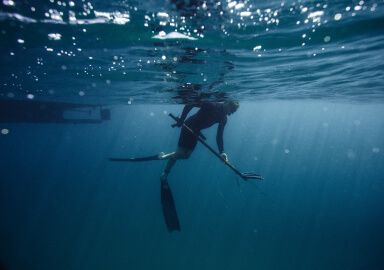Lobster
Lobsters are large-clawed crustaceans that inhabit rocky areas of some temperate oceans and are a highly valuable, intensively managed marine resource.
View 8 listings
8
listings
–
price starting from
5
countries
–
to the nearest trip
Where and When?
American lobsters are distributed from Labrador southwards down the American east coast to Cape Hatteras in North Carolina. The European species occurs from northern Norway, south around the European coast, into the Mediterranean Sea, Black Sea and the shores of Morocco and the Azores. Both species are generally subtidal; the European species can range from 0 to 150 m. (0-492 ft.) and the American species has been reported to attain depths of 400 m. (1 570 ft), but both species are more commonly found from 4 to 50 m. deep (13.1-164 ft.).
Both species are creatures that live in underwater rocky areas. They are mostly nocturnal and spend most of the day under rocks or deep inside shelves. In Scotland, where free-diving is a popular way to catch them, the best time is very early in the morning when the lobsters are still near the mouths of caves and crevices. For trap fishing it is usually best to leave the traps overnight and check them in the morning. The best months to catch them vary, with June to late December being best. In places such as Maine, a proportion of adults are moulting (soft shelled) between November and July. The European species may be caught throughout the year.
About Lobster
“Lobster” is a term loosely used for many Decapod (ten legged) crustaceans. “True” lobsters have the front pair of “legs” greatly modified into very large and powerful claws, the “clawed lobsters”. Other crustaceans commonly called “lobsters” are spiny lobsters, scampi and freshwater crawfish. The most important clawed lobsters are probably the American (Homarus americanus) and European lobster (H. Gammarus). The American lobster is the largest crustacean and can attain a body length of 64 cm. (24 in.) and a mass of 20 kg. (40 lbs.). The European lobster reaches 60 cm. (23 in.), but only 6 kg. (13 lbs.). Both species have similar shapes, habits and life cycles, but, while the American species is bluish green to brown with red spines, the European lobster is a shiny dark blue or black.
Lobsters feed mostly on invertebrates, particularly bivalve molluscs such as mussels, but also sea urchins, starfish and marine worms. They are found from the intertidal zone to deep offshore. They mate in summer and then the female carries her eggs for approximately a year before they hatch and swim off as planktonic larvae. These drift great distances before settling out and developing on the ground. They shed their carapaces regularly, several times per year when young and less often as adults.
How to Catch?
In American and Canadian waters lobster fishing is controlled by a detailed and complex set of rules and regulations that can vary by state and country. Generally, it is seen as an almost exclusively commercial fishery that is jealously guarded from other users. In Maine , for example, commercial fishing is rigidly controlled with little scope for new operators and, while recreational fishing is allowed, it is restricted to a few individuals who have to conform to strict requirements. European fishing is more open and recreational fishing is not controlled beyond size, bag and other measures to wisely manage the stocks. For both species the two most popular ways to catch lobsters are by using traps and free-diving or snorkeling.
Trapping is usually tightly controlled, by permits, as to locality, season, trap design and number, as well as many conditions as to which lobsters may be kept. Generally, traps are set offshore, left overnight and checked in the morning. The best baits are salted herring or any available bony fish parts that are locally available. Diving, where allowed, can be fun, exciting and challenging. Basically, divers swim down to suitable rocky areas, spot a lobster and then, usually using a long hooked rod, try to ease the lobster out of its hiding place. As it is chased out the diver grabs it by the body, carefully avoiding the very dangerous claws.








